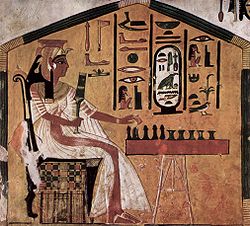QV66
| QV66 | |||
|---|---|---|---|
| Burial site of Nefertari | |||

Nefertari playing Senet
|
|||
| Coordinates | 25°43′40.3″N 32°35′33.4″E / 25.727861°N 32.592611°ECoordinates: 25°43′40.3″N 32°35′33.4″E / 25.727861°N 32.592611°E | ||
| Location | Valley of the Queens | ||
| Discovered | 1904 | ||
| Decoration | Book of the Dead | ||
| Layout | Generally straight | ||
|
|||
|
← Previous
QV65
Next →
QV67 |
QV66 is the tomb of Nefertari, the Great Wife of Pharaoh Ramesses II, in Egypt's Valley of the Queens. It was discovered by Ernesto Schiaparelli (the director of the Egyptian Museum in Turin) in 1904. It is called the Sistine Chapel of Ancient Egypt. Nefertari, which means "beautiful companion", was Ramesses II's favorite wife; he went out of his way to make this obvious, referring to her as "the one for whom the sun shines" in his writings, built the Temple of Hathor to idolize her as a deity, and commissioned portraiture wall paintings. In the Valley of the Queens, Nefertari's tomb once held the mummified body and representative symbolisms of her, like what most Egyptian tombs consisted of. Now, everything had been looted except for two thirds of the 5,200 square feet of wall paintings. For what still remains, these wall paintings characterized Nefertari's character. Her face was given a lot of attention to emphasize her beauty, especially the shape of her eyes, the blush of her cheeks, and her eyebrows. Some paintings were full of lines and color of red, blue, yellow, and green that portrayed exquisite directions to navigating through the afterlife to paradise.
A flight of steps cut out of the rock gives access to the antechamber, which is decorated with paintings based on Chapter 17 of the Book of the Dead. This astronomical ceiling represents the heavens and is painted in dark blue, with a myriad of golden five-pointed stars. The east wall of the antechamber is interrupted by a large opening flanked by representation of Osiris at left and Anubis at right; this in turn leads to the side chamber, decorated with offering scenes, preceded by a vestibule in which the paintings portray Nefertari being presented to the gods who welcome her. On the north wall of the antechamber is the stairway that goes down to the burial chamber. This latter is a vast quadrangular room covering a surface area about 90 square meters, the astronomical ceiling of which is supported by four pillars entirely covered with decoration. Originally, the queen's red granite sarcophagus lay in the middle of this chamber. According to religious doctrines of the time, it was in this chamber, which the ancient Egyptians called the "golden hall" that the regeneration of the deceased took place. This decorative pictogram of the walls in the burial chamber drew inspirations from chapters 144 and 146 of the Book of the Dead: in the left half of the chamber, there are passages from chapter 144 concerning the gates and doors of the kingdom of Osiris, their guardians, and the magic formulas that had to be uttered by the deceased in order to go past the doors.
...
Wikipedia

